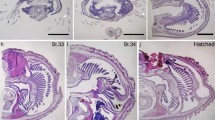Abstract
True accessory nuclei with the characteristic “double” membrane structure have been observed in the oocytes of the dipterans (Nematocera) Phryne cincta and P. fenestralis. They seem to arise from proliferations of the nuclear membrane. Although they often cling to the nucleus after their formation, they differ from it in certain structural details; their inner membranes are less electron-dense, and they have a greater frequency of pores.
Similar content being viewed by others
References
Bauer, H.: Die wachsenden Oocytenkerne einiger Insekten in ihrem Verhalten zur Nuklealfärbung. Z. Zellforsch. 18, 254–298 (1933)
Bauer, H.: Gekoppelte Vererbung bei Phryne fenestralis und die Beziehung zwischen Faktorenaustausch und Chiasmabildung. Biol. Zbl. 65, 108–115 (1946)
Bier, K.: Zur Funktion der Nährzellen im meroistischen Insektenovar unter besonderer Berücksichtigung der Oogenese adephager Coleopteren. Zool. Jb. Physiol. 71, 371–384 (1965)
Blochmann, Fr.: Über die Metamorphose der Kerne in den Ovarialeiern und über den Beginn der Blastodermbildung bei den Ameisen. Verh. naturh. med. Verein Heidelberg. N.F. 3, 243–247 (1884)
Blochmann, Fr.: Über die Reifung der Eier bei Ameisen und Wespen. Festschrift. Naturh. med. Verein Heidelberg 1886
Buchner, P.: Vergleichende Eistudien. I. Die akzessorischen Kerne des Hymenoptereneies. Arch. mikrosk. Anat. 91, 1–202 (1918)
Cassidy, J.D., King, R.C.: Ovarian development in Habrobracon juglandis (Ashmead) (Hymenoptera: Braconidae). I. The origin and differentiation of the oocyte-nurse cell complex. Biol. Bull. 143, 483–505 (1972)
Hopkins, C.R.: The histochemistry and fine structure of the accessory nuclei in the oocyte of Bombus terrestris. Quart. J. Microsc. Sci. 105, 475–480 (1964)
Israelewski, N.: The relation of radiation sensitivity to pronuclear chromosome structure. I. Different radiation sensitivities between Drosophila melanogaster and Phryne cincta. Chromosoma (Berl.) 67, 219–232 (1978)
King, P.E., Fordy, M.R.: The formation of “accessory nuclei” in the developing oocytes of the parasitoid hymenopterans Ophion luteus (L.) and Apanteles glomeratus (L.). Z. Zellforsch. 109, 158–170 (1970)
King, P.E., Richards, J.G.: Accessory nuclei and annulate lamellae in Hymenopteran oocytes. Nature (Lond.) 218, 488 (1968)
Meng, C.: Strukturwandel und histochemische Befunde insbesondere am Oosom während der Oogenese und nach der Ablage des Eis von Pimpla turionellae L. (Hymenoptera, Ichneumonidae). Roux's Arch. 161, 162–208 (1968)
Meng, C.: Autoradiographische Untersuchungen am Oosom in der Oocyte von Pimpla turionellae L. (Hymenoptera). Roux's Arch. 165, 35–52 (1970)
Palévody, C.: Presence de noyaux accessoires dans l'ovocyte du Collembole Folsomia candida Willem (Insecte Apterygote). C. r. Acad. Sci (Paris) D, 274, 3258–3261 (1972)
Pantel, Y.: Recherches sur les dipteres à larves entombies. II. Les enveloppes de l'oeuf avec leurs dépendances, les dégats indirects du parasitisme. La Cellule 29, I. Fasc. (1913)
Reynolds, E.S.: The use of lead citrate at high pH as an electron-opaque stain in electron microscopy. J. Cell Biol. 17, 208–212 (1963)
Ruthmann, A.: Basophilic lamellar systems in the crayfish spermatocyte. J. biophysic. biochem. Cytol. 4, 267–274 (1958)
Sokoloff, S., Zacharias, H.: Functional significance of changes in the shape of the polytene X Chromosome in Phryne. Chromosoma (Berl.) 63, 359–384 (1977)
Telfer, W.H.: Development and physiology of the oocyte-nurse cell syncytium. Advanc. Insect Physiol. 11, 223–319 (1975)
Wolf, B.E.: Über die Entstehung von accessorischen Kernen im Ei von Phryne fenestralis (Diptera). Moderne Biologie, Festschrift f. Hans Nachtsheim, 251–274. Berlin: F.W. Peters 1950
Wolf, B.E.: Temperaturabhängige Allozyklie des polytänen X-Chromosoms in den Kernen der Somazellen von Phryne cincta. Chromosoma (Berl.) 8, 396–435 (1957)
Wolf, B.E., Sokoloff, S.: Changes in the form of the polytene X-Chromosome in Phryne (Sylvicola) cincta-causes and functional significance. Chromosomes today 5, 91–108 (1976)
Author information
Authors and Affiliations
Rights and permissions
About this article
Cite this article
Meyer, G.F., Sokoloff, S., Wolf, B.E. et al. Accessory nuclei (nuclear membrane balloons) in the oocytes of the dipteran Phryne . Chromosoma 75, 89–99 (1979). https://doi.org/10.1007/BF00330627
Received:
Accepted:
Issue Date:
DOI: https://doi.org/10.1007/BF00330627




